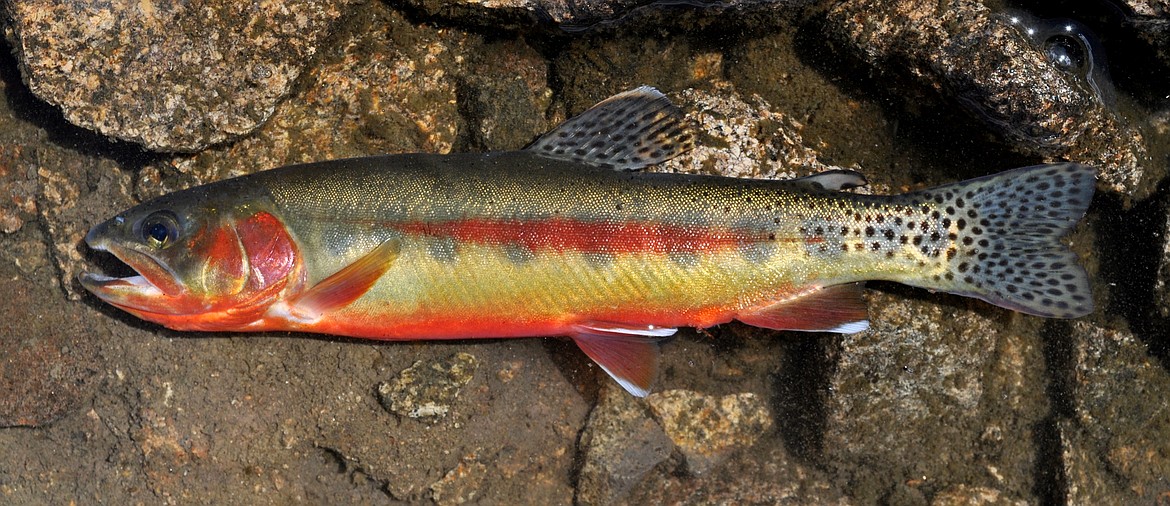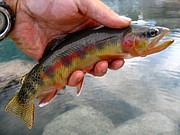There's gold in them hills
By RALPH BARTHOLDT
Staff Writer
It is the kind of story that is ripe for retelling.
And like sourdough, each batch is different.
In this story, Chuck “Right Stuff” Yeager and a fellow pilot were imbibing at an officer’s club in an Air Force base in the Mojave Desert. They concocted a plan to use government planes and equipment to introduce a favorite trout species into a high mountain lake where they liked to fish.
This version of high tech bucket biology ended well, with a new population of golden trout.
Yeager was so fond of catching golden trout, that from the seat of a plane he scouted lakes in the High Sierras that he thought might hold goldens. He then hiked 24 miles to elevations of 13,000 feet to find them.
In North Idaho, several Panhandle lakes have populations of golden trout and hiking is still the best way to get there.
Forage Lake in the St. Joe River drainage is a 6-acre lake at an elevation around 6,000 feet. The Idaho Department of Fish and Game began planting golden trout in the lake in the 1970s, including plantings of 4,000 fish in 1977 and 3,300 in 1979. The stocking program has continued in Forage Lake, accessed by a non-motorized trail from the Spruce Tree campground, and includes grayling.
Just like the method Yeager and his Air Force pal used to drop fish into mountain lakes, Idaho Fish and Game stocks 6-inch golden trout every few years using low-flying airplanes.
“The plane flies over the lake at low altitude and dumps the fish,” regional fishery manager Andy Dux said.
Most of the golden trout and grayling grow to around 12 inches with a few reaching 14 to 16 inches, Dux said. The latest batch of 2,100 golden trout was stocked last September in Forage Lake.
Long Canyon Lake and Parker Lake in the Selkirk Mountains also receive shipments of golden trout.
Fish and Game stocks grayling in Crater and Steamboat lakes in the southern St. Joe and upper Clearwater river drainages. Graylings are also stocked in Callahan Lake in the Kootenai River drainage and in Long Mountain Lake in the Selkirk Mountains.
Golden trout are stocked during odd years on a two-year rotation, Dux said, or when fish become available. The program works in conjunction with California Department of Game and Fish, which provides golden trout to western states including Idaho.
Fish and Game conducts irregular surveys on some of the lakes, which can be affected by winter kill. Drought years followed by severe winter conditions can cause lakes to freeze from top to bottom, and lakes high in organic matter are also suspect.
When lakes with a lot of aquatic plant growth freeze early in the season, and stay frozen and snow covered for longer than usual, dead organic matter starts to decompose and use up oxygen. Depleted oxygen levels — below the four parts per million that trout need — can result in a fish die-off.
For anglers who hike a long way to pull a spinner or cast a fly on a high mountain lake, that may not be all bad. Surviving fish fare better with less competition and may grow bigger.
“A lot of that is density driven,” Dux said. “Once the density goes down, the fish size goes up.”
Although Fish and Game conducts occasional surveys, the department hasn’t done a high mountain lake survey in almost a decade. And because anglers who hike to the far-away gems to catch golden trout or grayling don’t meet many department employees on the way down, the department doesn’t usually receive feedback.
“We don’t often get fishing reports,” Dux said.





